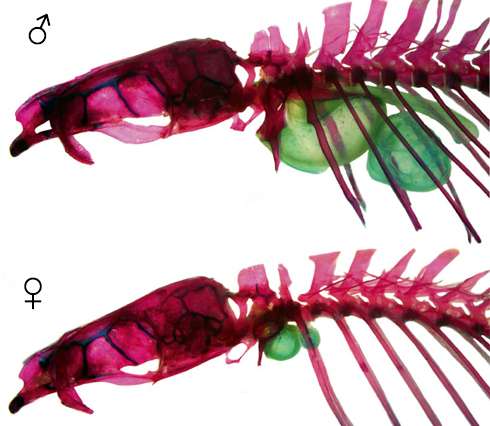Researchers discover a rare case of internal differences between the sexes of one fish genus

A team of scientists, including Museum fish researcher Dr Ralf Britz, have discovered that in one genus of fish the swimbladder, the organ used for buoyancy in water, is greatly enlarged in the males.
The larger swimbladder in males can be up to 98 times greater in volume, and is accompanied by a strange, unidentified organ that the females lack altogether.
Most differences between males and females of the same species of animal are external, such as body size or elaborate colouring. Apart from the gonads, there are few examples of organs inside the body being different.
Staying afloat
Members of Psilorhynchus, the genus of fish studied, are commonly known as South Asian torrent minnows, because they live in fast-flowing water.
The swimbladder is normally used to keep fish buoyant, but in fast-flowing water a buoyant fish could easily be swept away in the currents, so that fishes in this habitat usually have very small or absent swimbladders.
The male Psilorhynchus however doesn't have a problem in the water despite his larger swimbladder. Dr Britz and colleagues think this may be because the male has larger bones and muscles, adding weight to the body and offsetting the greater buoyancy.
Making noise
The different bone and muscle composition may also help explain what the mystery organ is for. Sitting on top of the swimbladder is a unique tuning-fork shaped organ made of dense connective tissue.
Changes in the muscles and skeleton surrounding the swimbladder in other similar fishes are often associated with sound production. Although the tuning-fork organ is unique among fishes, together with the modified skeleton and muscle, it may have a similar function.
'We think that the modified muscle is a drumming muscle, using the enlarged bone to drum against the swimbladder like a drumstick,' said Dr Britz.
The fast-flowing water that Psilorhynchus lives in is a very noisy environment, and this may explain why the males make such an effort to produce a sound that could be difficult to hear.
Surprising discovery
The genus Psilorhynchus has been known for 170 years, but it was only when lead author Dr Kevin Conway studied its internal anatomy that the enlarged swimbladder was discovered. It was analysed in detail in collaboration with Dr Britz and Dr Dustin Siegel. The enlarged swimbladder in males occurs in all but one of the species in the genus.
'Our study nicely demonstrates that there still are scientific mysteries remaining to be discovered, one just needs to look,' said Dr Britz.
Provided by Natural History Museum




















